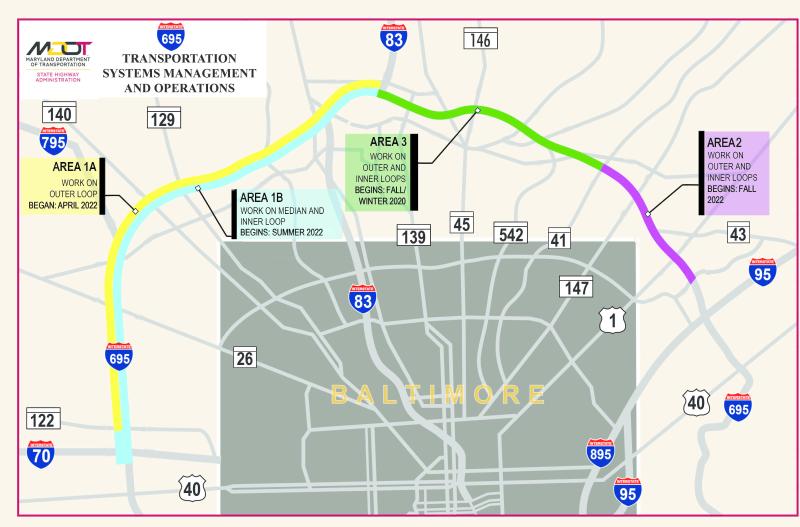(April 14, 2022) – The Maryland Department of Transportation State Highway Administration (MDOT SHA) has begun minor pavement and stormwater management improvements and is conducting other construction work on the outer loop right shoulders of I-695 between south of MD 122 (Security Boulevard) and I-83 (Baltimore-Harrisburg Expressway).
The work is part of the Transportation Systems Management and Operations (TSMO) project for I-695 (Baltimore Beltway) between I-70 and MD 43 (White Marsh Boulevard), aimed at reducing congestion and increasing reliability on nearly 19 miles of the beltway. The $173.6 million project is part of Governor Larry Hogan’s
Traffic Relief Plan for the Baltimore region.
“This congestion relief project will help Baltimore Beltway commuters save valuable time every day,” said MDOT Secretary James F. Ports, Jr. “Once constructed, this innovative approach will allow both commuters and commerce to move more freely throughout the region.”
In addition to the pavement widening, shoulder rehabilitation, reconstruction, stormwater management and drainage improvements, crews will install underground conduit; post new highway signage; apply pavement markings; and make highway lighting improvements.
Pre-construction activities on the outside shoulders of the outer loop of I-695 began last year. In February, crews started installing conduit and underground infrastructure to support Intelligent Transportation Systems. In addition, work is tentatively scheduled to begin in July on the inner loop shoulder of I-695 between I-70 and I-83.
In September, additional work will be performed on the inner and outer loop shoulders between MD 41 and MD 43. Work on the final segment, the shoulders of the inner and outer loop between I-83 and MD 41 (Perring Parkway), will begin in November.

Once completed, anticipated for spring 2024, motorists will be able to utilize the median (left side) shoulders during peak morning and evening rush hours on the inner and outer loops of the Baltimore Beltway when available. Lane use control signals, like those on the Bay Bridge and Fort McHenry Tunnel, will clearly indicate when the shoulder can be used for travel.
TSMO will address congestion at four of the top five most congested road segments of the Baltimore Beltway and is expected to save commuters up to 21 minutes during peak-traffic times.
For more information, visit the project portal page.
“The forward-thinking elements of this project allow us to better utilize our existing roadway footprint so we can safely and more efficiently reduce congestion and keep traffic flowing,” said MDOT SHA Administrator Tim Smith. “Incorporating technology with traditional roadway infrastructure improvements is how this TSMO project will deliver tangible results for our highway users.”
In 2017, Governor Hogan committed to innovative congestion relief on the inner and outer loops of the Baltimore Beltway as part of his Baltimore Traffic Relief Plan. Other phases of the relief plan include the I-95 Express Lane Extension to MD 24 (Veterans Memorial Highway), which is underway; and the I-695 Interchange at I-70 (Triple Bridges) Project, which is in the planning stage.
MDOT SHA works hard to maintain safe traffic mobility in work zones for our crews as well as our customers. Drivers need to stay alert, focus on driving, and look for reduced speed limits as well as other driving pattern changes. Please drive like you work here and slowdown in construction zones. Motorists can dial #77 on their mobile devices for roadside assistance.
Governor Hogan has proclaimed April as Work Zone Safety Month in Maryland.
Click here for more information on Work Zone Safety. Also follow MDOT SHA on Twitter
@MDSHA and on Facebook at
facebook.com/MDOTSHA.
For a list of all major MDOT SHA projects, go to
Project Portal. For a look at real-time traffic conditions, go to
md511.maryland.gov.